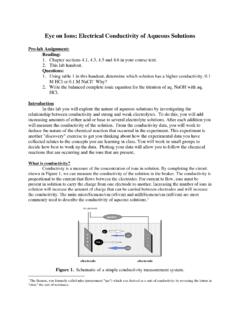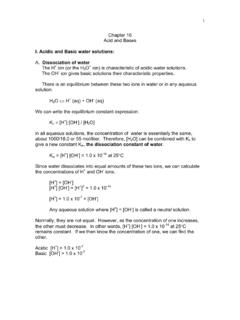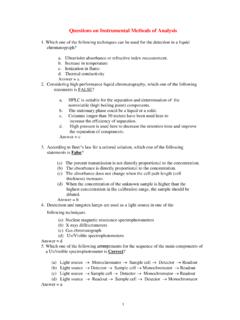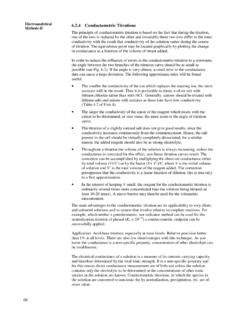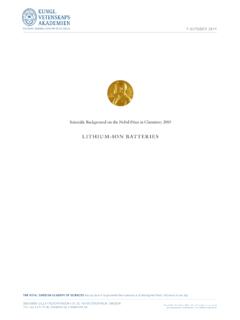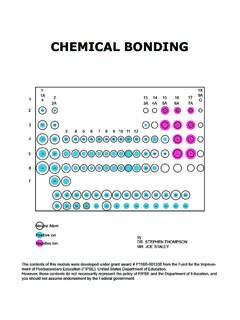Ions Electrical Conductivity Of Aqueous Solutions
Found 10 free book(s)Eye on Ions: Electrical Conductivity of Aqueous Solutions
web.colby.eduEye on Ions: Electrical Conductivity of Aqueous Solutions Pre-lab Assignment: Reading: 1. Chapter sections 4.1, 4.3, 4.5 and 4.6 in your course text. 2. This lab handout. Questions: 1. Using table 1 in this handout, determine which solution has a higher conductivity, 0.1 M HCl or 0.1 M NaCl? Why? 2.
I. Acidic and Basic water solutions: Dissociation of water O
www.sas.upenn.edugenerally true for all polyprotic acids; essentially all of the H+ ions come from the first dissociation. C. Determining Experimentally Measure electrical conductivities of solutions. 0.10M HF will have low conductivity since small amount of ions to conduct a current. 0.10M HCl has a high conductivity, 10 times that of HF. IV. Strong and Weak Bases
SOLUBILITY, IONIC STRENGTH AND ACTIVITY COEFFICIENTS ...
homepages.wmich.eduof interest and also on the diameters of ions of opposite sign that may be present in the solution. For aqueous solutions at 25oC, the value of A is 0.509; for Ca(IO 3) 2 with KCl ions, a value of B = 1.09 at 25oC seems to give the best value of the slope. Combining Eq. (8) for the (+) and (-) ions gives Eq. (10) for γ ±. Correspondingly Eq ...
Questions on Instrumental Methods of Analysis
www.philadelphia.edu.joAqueous KMnO 4 solutions are purple. A plot of absorbance against concentration is: a. non-linear. b. linear with a negative gradient. c. linear with a positive gradient. d. an exponential curve. Answer = c 37.A shift to lower wavenumber for an absorption in a spectrum corresponds to: a. a loss of intensity. b. a shift to lower wavelength.
Conductance Measurements Part 1:Theory
www.currentseparations.comConductivity and Concentration The experimentally determined conductivity reflects contributions from all ions present in solution that are mobile and can support the cur-rent. Conductivity can be written in terms of the mobilities of all of the ions present (3): where F is the Faraday constant (96,485 C/mol), and Ci is the con-
Electroanalytical 6.2.4 Conductometric Titrations Methods-II
www.tau.ac.ilhydrogen ions by the added cation as H + ions react with OH − ions to form undissociated water. This decrease in the conductance continues till the equivalence point. At the equivalence point, the solution contains only NaCl. After the equivalence point, the conductance increases due to the large conductivity of OH-ions (Fig. 6.2).
LITHIUM-ION BATTERIES - Nobel Prize
www.nobelprize.orgsame time, Y. Yao and J.T. Kummer studied ionic conductivity in solids, and showed that sodium ions can move at the same rate in solids as in salt melts.16 Kummer also proposed the use of this configuration for batteries in a patent from 1969.17 At the same time, John Newman developed a theory for ion transfer in electrochemical cells.18 Figure ...
pH in Drinking-water - WHO
www.who.intimparted by bicarbonate, carbonate, and hydroxyl ions, this temperature effect is modified (1). The pH of most raw water lies within the range 6.5–8.5 (1). ANALYTICAL METHODS The pH of an aqueous sample is usually measured electrometrically with a glass electrode. Temperature has a significant effect on pH measurement (1,2).
pH in Drinking-water - WHO
www.who.inthydroxyl ions, this temperature effect is modified (APHA, 1989). The pH of most drinking-water lies within the range 6.5–8.5. Natural waters can be of lower pH, as a result of, for example, acid rain or higher pH in limestone areas. 2. ANALYTICAL METHODS The pH of an aqueous sample is usually measured electrometrically with a glass electrode.
Chemical Bonding - Colorado State University
www.smallscalechemistry.colostate.eduIONS: COUNTING ELECTRONS AND PROTONS Li 3+ In the pictures below, draw in the number of elec-trons required to make the atom neutral and write the element symbol in the box to the left of the atom. 11+ 17+ 8+ 9+ NEUTRAL ATOMS POSITIVE IONS Positive ions have more protons than electrons. Since the number of protons an atom has is fi xed in
